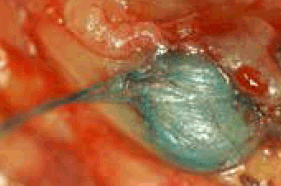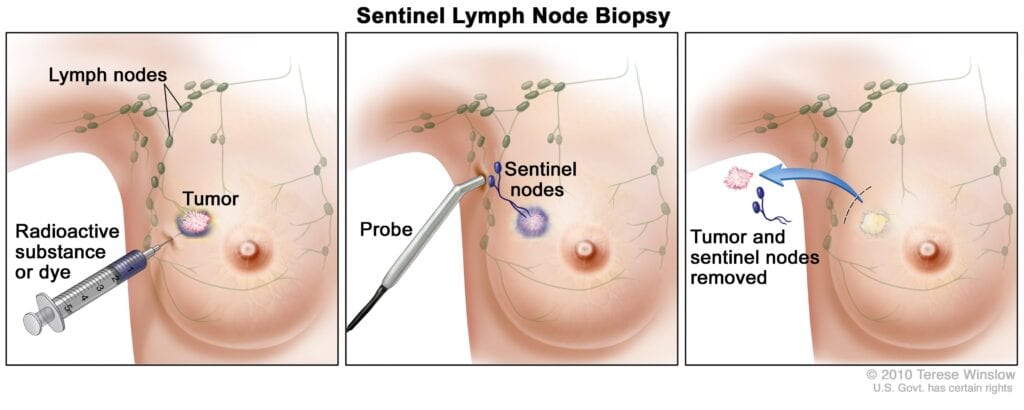When you are diagnosed with breast cancer your breast surgeon may talk to you about a procedure called a sentinel lymph node biopsy. We are going to discuss what that procedure means in this section.
What are Lymph Nodes?
Lymph nodes are part of your immune system.This is a network of tissues and organs that helps rid the body of toxins, waste and other unwanted materials. The body contains hundreds of scattered lymph nodes. A system of very thin lymphatic vessels connects them to each other. We know that each part of the body drains to a specific cluster of lymph nodes. The easiest way to understand the function of a lymph node is to think of it as a filter. It traps many things such as bacteria, viruses, dead cells and even cancer cells. Sometimes when they trap these things they become enlarged and you can feel them . Sometimes we can see them on a mammogram or ultrasound but we can’t feel them.
The breasts mostly drain to the lymph nodes that are clustered in the armpit or axilla on the same side. They can also drain to clustered lymph nodes on either side of the breast-bone . As a breast cancer begins to grow within the breast, some of the cancer cells may break off. They access the tiny lymphatic vessels and travel to the closest lymph nodes, called the sentinel lymph nodes. We call them this because they are standing guard and are the first line of defense for that part of the breast.
Sometimes, the lymph node is able to trap and kill the cancer cells. On other occasions, the sentinel lymph node will become overloaded with cancer cells. We call this a nodal or regional metastasis. Over time, those cells will spread to the other lymph nodes and ultimately to other parts of the body. When this happens we call it distant metastases.
Sentinel Lymph Node Procedure
Initially, breast cancer surgery would include removal of all the lymph nodes in the axilla. Unfortunately, this would place the patient at risk for significant arm swelling, or lymphedema. In the mid 1990s, we discovered that breast cancer spreads to the sentinel lymph node first. From there it spreads to other nodes.

Dr. Armando Giuliano at the John Wayne Cancer Center in California injected a blue dye into the breast prior to surgery. The sentinel lymph node or nodes would then turn blue. We can remove them without disrupting the other lymph nodes. This significantly decreases the risk of lymphedema. We can also perform the same procedure with a radioactive dye as doctors subsequently discovered. We inject the dye in the breast and detect it in the operating room with a hand-held device. A surgeon can use one or both dyes to detect the sentinel lymph nodes. The chances of other lymph nodes being cancerous is well under 5% if the sentinel node is clean. Currently, surgeons can avoid removing all of the lymph nodes if the sentinel lymph node is clean of cancer cells.

The current standard of care is to perform a sentinel lymph node biopsy if there are no signs of axillary node involvement with cancer. We do this regardless of whether a woman is having a mastectomy or preserving her breast. We don’t remove more lymph nodes if the sentinel lymph node or nodes are negative. That way we can significantly reduce the risk of lymphedema. Sometimes all the lymph nodes must be removed at the initial or a subsequent surgery but we will discuss this in a different post. We will also discuss the role of sentinel lymph node biopsy after neoadjuvant chemotherapy in a later post.